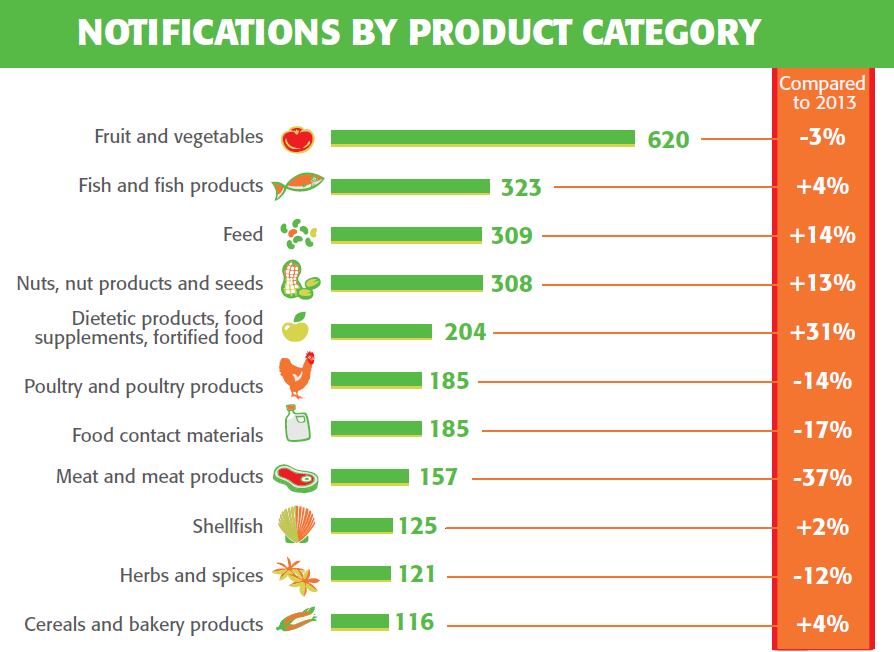Examples from China include unauthorised substances anthraquinone, carbendazim and chlorfluazuron; imidacloprid and acetamiprid pesticide residues in tea and broccoli.
Migration of chromium in food contact materials and aflatoxins in nuts, nut products and seeds are other examples, according to the RASFF 2014 annual report.
In total, fruit and vegetables (620) topped notifications by product category, although this figure dropped from 2013.
Fish and fish products (323), nut, nut products and seeds (308) and dietetic foods, food supplements, fortified foods (204) notifications all rose.
RASFF notifications on meat and meat products (-37%), food contact material (-17%) and poultry and poultry products (-14%) all fell while dietetic products, food supplements, fortified food notifications jumped (31%) and feed (14%) and nut, nut products and seeds (13%) both rose.
Types of notification
In 2014, 3157 original notifications were transmitted through the RASFF, 751 were classified as alert, 410 as information for follow‑up, 623 as information for attention and 1373 as border rejection notification.
These original notifications gave rise to 5910 follow‑up notifications, representing an average of about 1.9 per original notification. For alert notifications this average rises to 4.4 follow‑ups per original notification.
The alert notifications figure has increased by more than 25% while the other notification types were reported significantly less, compared to 2013.
Overall figures present a 1.1% decrease in original notifications compared to 2013 but a 14.6% increase in follow‑up notifications, resulting in an overall increase of 8.7%.

Vytenis Andriukaitis, commissioner for Health and Food Safety, said RASFF is being reviewed as part of the REFIT (Regulatory Fitness and Performance) programme started last year.
“An important improvement is already being implemented, as part of lessons learned from the 2011 E. coli outbreak: a new faster approach to the investigation of foodborne outbreaks,” he said.
“This implies better coordination with public health authorities, more accurate collection of food traceability data and a precise analysis of possible causes of foodborne outbreaks.
“Once the cause is identified, improved traceability will allow food controllers to more swiftly target and withdraw products from the market.”
Food poisoning and supplement cases
Last year saw 50 cases where food poisoning was reported in a RASFF notification.
One example was a foodborne outbreak suspected to be caused by cherry tomatoes from Morocco.
Different batches were implicated and two tomato varietals were identified (round cherry tomatoes without stalks and cocktail‑type round cherry tomatoes on the vine).
All batches of cherry tomatoes implicated came from three production units at the same place in Morocco.
Pathogenic micro‑organisms (782) topped the notifications by hazard category, pesticide residues (435), mycotoxins (383) and heavy metals (285) made the top four.
The number of STEC notifications dropped in 2014 from the peak number reached in 2013.
The Commission is working on a guidance document concerning food contaminated with STEC providing Member States confronted with positive results with guidance.
For Salmonella there was a modest decrease for most products. This trend is most significant for fruits and vegetables while poultry and feed materials remain the most reported categories.
Italy sent 16 notifications about smoked salmon from the same Polish producer in which Listeria monocytogenes was reported.
Other product categories often reported for Listeria monocytogenes are cheeses mostly from France (11) and from Italy (10) and meat products.
The composition of food supplements and dietetic products continues to be a big concern because of health concerns in relation to some substances found that are often not labelled.
It also remains a challenge to perform effective enforcement, due to the majority of the products notified being sold via internet.
A total of 88 notifications were due to unauthorised substances including DMAA, yohimbine, vinpocetine, vanadium, synephrine and lithium.
There were 28 notifications about novel food ingredients in 2014 including betaine, mucuna pruriens and Siraitia Grosvenorii.
RASFF notifications report on risks identified in food, feed or food contact materials that are placed on the market in the notifying country or detained at an EU point of entry at the border with an EU neighbouring country.
